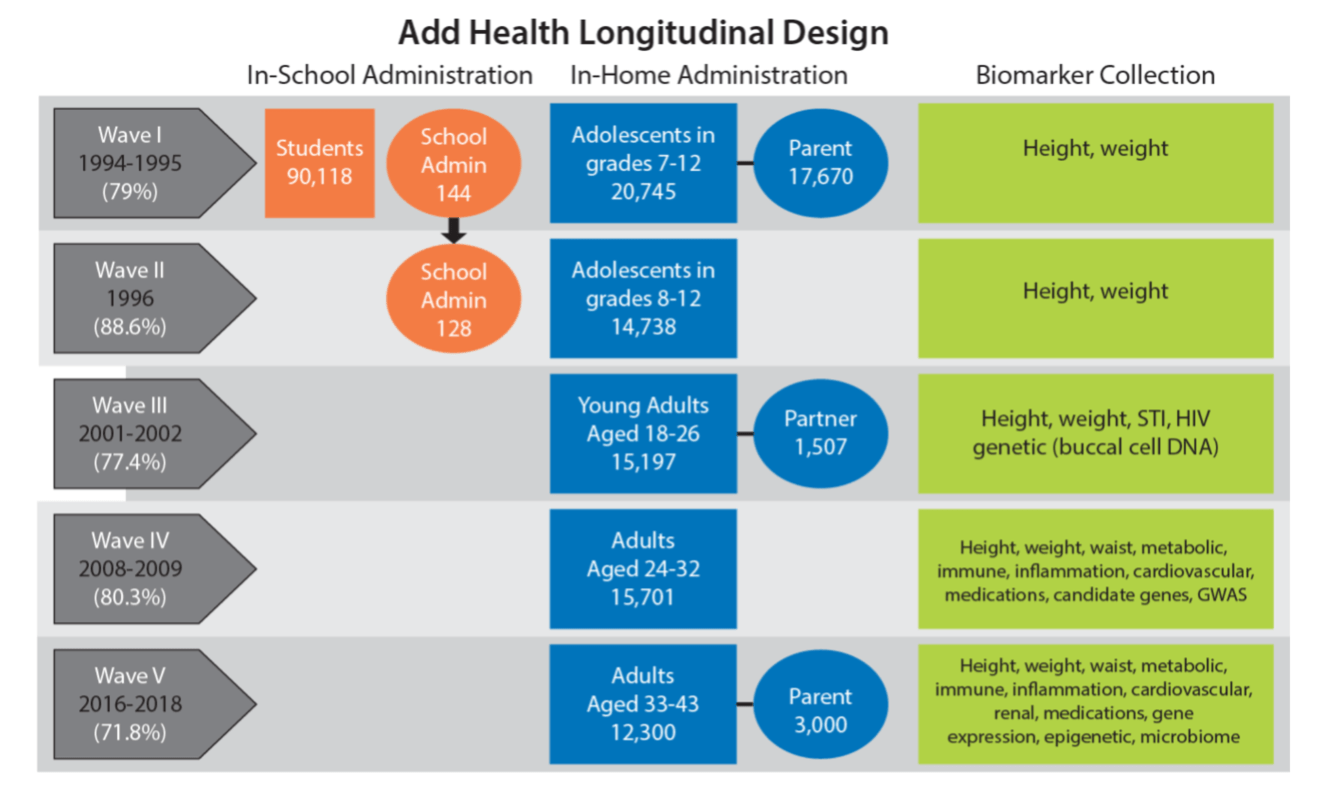http://www.cpc.unc.edu/projects/addhealth
Overview
The National Longitudinal Study of Adolescent to Adult Health (Add Health) is a longitudinal study of a nationally representative sample of adolescents in grades 7-12 in the United States during the 1994-95 school year. Add Health combines longitudinal survey data on respondents’ social, economic, psychological and physical well-being with contextual data on the family, neighborhood, community, school, friendships, peer groups, and romantic relationships, providing unique opportunities to study how social environments and behaviors in adolescence are linked to health and achievement outcomes in young adulthood. The original design included important features for understanding biological processes in health and developmental trajectories across the life course of young people, including an embedded genetic sample with more than 3,000 pairs of adolescents with some varying resemblance (e.g., twins, full sibs, half sibs and adolescents who grew up in the same household but have no biological relationship), testing of saliva and urine for sexually transmitted infections and HIV, and DNA collection on a subset of the genetic sample in 2001. The fourth wave of interviews in 2008 expanded the collection of biological data in Add Health to understand the social, behavioral, and biological linkages in health trajectories as the Add Health cohort ages through adulthood. The fifth wave interviewed cohort members to collect social, environmental, and biological data from 2016-2018.
Data Collection
The first wave of Add Health included a stratified, random sample of all high schools in the United States and an in-home sample of 27,000 adolescents. The Add Health cohort has been followed into young adulthood with four follow-up in-home interviews, and the sample was aged 32-42 during the 2016-2018 Wave V data collection.
Biomarkers
Add Health has collected anthropometric data at all waves, beginning in adolescence. These measures include height, weight, and waist circumference at wave IV. Collection of biospecimen and DNA began in 2001 at Wave III. At Wave III, Add Health respondents were asked to provide saliva and urine specimens for HIV and STD testing (N~15,000). A subsample of full siblings and twins was also asked to provide a saliva sample for genetic analysis (N~2,500). STD (but not HIV) results are released with the survey data via restricted data use contracts, as are some candidate gene results. At Wave IV, additional biomarkers were collected, which include cardiovascular measures (systolic and diastolic blood pressure, pulse, and pulse pressure), metabolic measures (dried blood spots were assayed for lipids, glucose, and glycosylated hemoglobin), and measures of inflammation and immune function (high sensitivity C-reactive protein and Epstein-Barr virus (EBV) from dried blood spots). In collaboration with the Institute for Behavioral Genetics (IBG) in Boulder, CO, Add Health collected, extracted, quantified, and stored DNA samples from all respondents in Wave IV. Candidate and genome-wide genotyping using GWAS was done on the approximately 12,000 Wave IV saliva samples from respondents who agreed to archive their specimens for future research. Biomarker collection of more extensive measures was done in wave V (Please see the table below).
